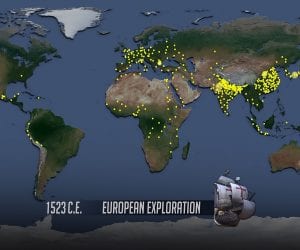In the lesson, “Oh, How We’ve Grown!” students experience changes in world population in two ways – first, students will create a timeline that depicts world population doubling throughout history, and second, students actively simulate world population growth from 1510 to 2010.
In part one, students use adding machine tape to make a timeline illustrating the number of years that it’s taken human population to double throughout history. Students convert the number of years it took for the world population to double into a measurement (meter sticks). Then, students measure out the lengths of “time” it took for the population to double on the paper. It is a powerful visual – the final timeline is roughly 6 meters long! Students can clearly see each doubling of the population though the different lengths.
In part 2, students experience the changing pace of population growth by physically simulating the Earth’s population growth over the last 500 years. Using 30 feet of yarn to create a circle representing the planet, students will count from 1 to 100 to travel through time from 1510 to 2010. Each student will receive a counting card (supplied in the activity) and as the number on their counting card is reached, they will step into the circle of yarn and increase the world population by 250 million people. Not only is this a great visual, but it’s also going to create a feeling of crowding among your students in the circle, so they will also feel the effects of the population growth!
An important follow up question to ask students after both parts have been completed is, “Can the earth’s population go on doubling forever?” Have them think about resource use from water to energy to land for food, our trash and our homes and think about how much space we need. It’s essential for students to understand that the pattern of population growth has not been consistent through history, with our population growing much faster in modern times than even just 200 years ago. Exploring the advances in science, technology and medicine and it’s attributes to population growth throughout the last 500 years is also a great way to follow up the lesson plan.




